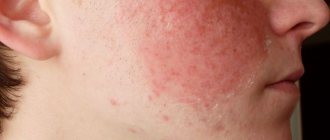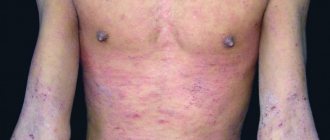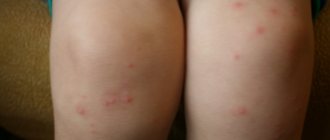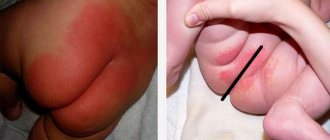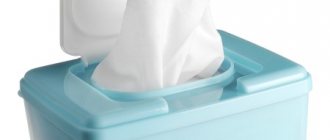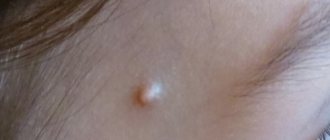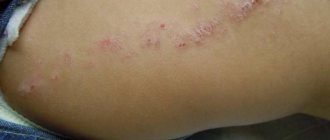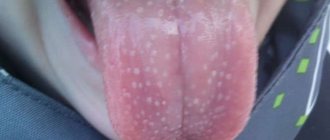Is acne in this area a common occurrence or a reason to see a doctor?
Precisely because a rash around a child’s mouth is a very common phenomenon, many do not attach much importance to it. The first thing that comes to the mind of adults is that the child simply wiped his mouth with dirty hands. Maybe that was the case, but sometimes the reasons for the appearance of rashes are more serious. Therefore, this problem cannot be ignored.
If the acne, despite the efforts made by the parents, does not go away within 3 days, then you should take your child to a doctor - a pediatrician, allergist or dermatologist.
Diagnosis of rashes
Symptoms such as irritation and peeling, itching around the mouth and other skin manifestations may have an allergic etiology, infectious or autoimmune. In the latter case, in addition to the skin rash, there is damage to other organs and systems, as well as general intoxication of the body.
First of all, when visiting a doctor with irritation around the mouth in a child or adult, information is collected about how long ago the symptoms occurred, their nature, and accompanying manifestations. An allergic history is examined to determine whether there have been cases of a similar reaction in the past. The hereditary factor is no less important.
To identify the allergen, allergy tests are performed. Differential analysis involves a biochemical study of salivary fluid or exudate from the mucous membrane, which makes it possible to identify or exclude bacterial infections.
If there is a suspicion of the development of a gastrointestinal disease, additional measures are taken:
- general and biochemical blood test;
- coagulogram;
- study for hepatitis markers;
- coprogram;
- endoscopic examination;
- colonoscopy;
- endoscopy;
- ultrasound analysis of internal organs.
It is possible to determine how to treat redness and peeling around the mouth, rash, and itching syndrome only after making a final diagnosis.
Rashes around the lips of a child: what could be the reason and how to remove them from the face?
Perioral dermatitis (that's what it is) usually appears as small, red papules. The child begins to rub them with his hands, which only worsens the situation. Something needs to be done, but before you take out baby cream or put your baby on a diet, it is advisable to figure out why he is breaking out.
So, if you notice a rash around your child’s mouth, the reasons may be:
- teething in infants. This process is accompanied by profuse salivation. Saliva irritates the baby's delicate skin - hence the rash. To correct the situation, you need to carefully treat the skin from time to time with a cotton pad soaked in baby moisturizing lotion. Before going to bed, it is better to lubricate this area with Bepanten cream;
- allergy. A small red rash surrounding the lips is a signal of an allergic reaction. It occurs suddenly and may be accompanied by rhinitis, redness of the eyes, and lacrimation. In children, such problems often arise due to the consumption of chocolates, strawberries, and citrus fruits. Ideally, you should identify the allergen and remove it from the diet (or exclude the child from contact with this substance). An antihistamine will help relieve the rash. Drugs such as Claritin, Fenistil, Loratadine act quickly and are relatively safe. Lorizan ointment also gives a good effect;
- dirt. If a baby, while walking outside, touches his lips with dirty hands or has not yet learned to eat neatly, so the contents of the plate flow down his chin, this will inevitably lead to irritation. The task of the elders is to monitor the hygiene of the boy or girl, to teach them not to touch their face with their hands. After each meal, you should wash it with baby soap and carefully dry it with a soft towel;
- consequences of vaccination. After vaccination, some babies may also develop a rash in the mouth. It is not recommended to do anything on your own in such cases - you should inform the doctor, who is obliged to monitor the condition of the vaccinated ward. In such a situation, the pediatrician may prescribe a homeopathic remedy or Viburkol suppositories;
- childhood infection. Some infectious diseases (chickenpox, measles, scarlet fever, rubella, infectious mononucleosis, herpes virus) begin with just such a symptom. But after the rash, other signs of illness appear (fever, swollen lymph nodes, photophobia), which makes it possible to suspect an infection. It is clear that in this case it is useless to fight only the rash - you need to call a doctor at home and treat the disease;
Preventing a rash is not as difficult as it might seem. Of course, you can’t stop drooling in a baby, but in other cases it is quite possible to eliminate the causes of its occurrence. Do not refuse vaccinations that protect against infections. Do not feed your child candy. Temper your child, teach him to keep his hands clean. Introduce new foods (including complementary foods) in small portions. Use children's hypoallergenic cosmetics and washing powders.
Parents are sensitive to the health of their child, so when a rash appears on the body, they try to help the baby in every possible way. Pimples on the body indicate the presence of diseases or the development of an infection, so the problem must be looked for inside. Once the root cause is eliminated, the rash disappears.
Treatment for adults
Therapy of a pathological process should be aimed at eliminating its causes. If a symptom is observed after using decorative cosmetics, toothpaste or cream, then it is recommended to avoid them. Also, patients should not use medications that have a local effect.
If the symptom occurs against the background of allergic diseases, then therapy is carried out using medications that have an antihistamine effect. Patients are advised not only to use ointments and creams, but also to take appropriate medications orally.
Redness around the mouth
Regardless of the cause of the pathological process, patients are recommended to take vitamin complexes and also use restorative medications. They should be developed on the basis of vitamin B6 and ascorutin, which will speed up the treatment process.
In advanced forms of the disease, the patient may be prescribed antibiotic therapy. During therapy, it is necessary to ensure that the skin is protected from solar radiation.
To eliminate the external manifestations of pathology, homeopathic remedies are often used:
Petroleum. With the help of this medicine, the skin is softened and moisturized. Medicine is an ideal option. If the symptom develops due to diseases of the nervous system of Mezereum. If irritation occurs due to nervousness, then patients are prescribed this drug
Its use should be carried out with the utmost caution, since a side effect is Graphite conjunctivitis. The drug is highly effective if the pathology occurs due to diseases of the cardiovascular system
During the period of use of the medicine, the walls of blood vessels and veins are smoothed, which leads to an improvement in the blood circulation of Sulfur. If a symptom occurs against the background of diseases of the digestive system, then its elimination is carried out using this particular medication. In most cases, the medicine is prescribed to people who have a short temper.
Treatment of redness around the mouth in adults should be carried out in accordance with the cause of the symptom, which will ensure its effectiveness.
Causes of acne around the mouth in a child
There are many reasons for the appearance of acne in the lip area. When they appear, parents grab baby cream and begin to moisturize the skin. In addition, the baby is put on a diet, expecting that the symptoms will go away on their own. However, this is not always enough.
If the rash en masse covers the area around the mouth, while there are no similar acne on other areas of the face, then perhaps we are talking about perioral dermatitis
The reason for the appearance of red or white dots around the nasolabial triangle may be:
Causes of seizures in children
Today, there are a number of reasons why spots in the corners of the mouth may occur:
- Lack of B vitamins. At the same time, the child has dry skin, brittle nails and split ends.
- Diseases of the gastrointestinal tract. At the same time, the absorption of beneficial elements and vitamins into the blood deteriorates.
- Bacteria. Failure to comply with hygiene often provokes the accumulation of pathogenic microorganisms, which, under favorable conditions, begin to actively multiply. This is especially common among children who put dirty hands into their mouths.
- Fungal infection. In this case, angulitis becomes a consequence of the activation of fungi of the genus Candida in the body.
- Deficiency of iron and zinc in the child's body. This phenomenon is typical with poor nutrition. When the diet does not include fresh vegetables and fruits, buckwheat porridge and greens.
- Inflammatory diseases of the oral cavity. Often the provocateur of this disease can be stomatitis.
- Decreased immunity. Children with weakened protective properties of the body often suffer from a similar disease.
- Infectious pathologies. Angulitis can be a consequence of scarlet fever, tonsillitis and other diseases.
- Allergy. The body's pathological reaction to certain foods can manifest itself in a similar way.
What are the types of rashes?
What can acne in a child’s mouth “tell”? The location, shape, color of pimples and the frequency of occurrence of the rash can suggest the root cause of their appearance.
Analyzing the appearance of the rash and where it appears helps the doctor prescribe the correct treatment. Types of rash:
If your baby develops a rash, you should immediately consult a doctor. Self-medication can aggravate the situation and the course of the disease. To avoid rashes, doctors recommend:
Maintain careful hygiene, wash your face at least 2 times a day with warm water, try not to touch your face with your hands during the day
- From infancy, teach your baby the rules of hygiene. Wash your hands and face thoroughly, and also take baths several times a week.
- Introduce complementary foods wisely. If you correctly introduce foods into your baby's diet, you will protect your baby from developing serious allergies.
- Monitor your child's metabolism. Avoid constipation.
- Take all tests on time. Get checked for helminths.
- Get all necessary vaccinations against infections.
Following these simple rules will help avoid unpleasant symptoms and possible complications of diseases.
Pimples in a child's throat
Not only manifestations on the skin can indicate the onset of a serious illness. Oddly enough, but in childhood the localization of the rash can be observed not only on the face, but also in the mouth .
The mucous membranes are affected by rashes of various types and types. If the skin’s reaction to unfavorable conditions can be prevented with a moisturizer, then what about problem areas on the child’s oral mucosa?
Causes of a rash in the baby's throat:
The red color and the appearance of a swollen, reddened surface of the mucous membrane indicate the presence of an acute inflammatory process
How to treat a rash in a child?
If you notice a rash on your baby, you need to show it to the doctor as soon as possible. He will analyze the general condition of the body, carry out appropriate diagnostic procedures and, based on them, make the correct diagnosis and prescribe adequate treatment.
First aid is:
- Rinse your mouth with soda solution. A weak soda solution does not harm children's mucous membranes. Soda has a calming, anti-inflammatory effect and reduces discomfort.
- Treating the location with aloe juice. You can use Iodinol to treat spots on the body.
Herbal decoctions of chamomile, calendula and yarrow are effective in folk medicine. These herbs soothe the oral mucosa as they have a bactericidal effect. Lotions and mouth rinses are considered useful.
The doctor prescribes:
- antiviral or antibacterial medications;
- analgesics to relieve pain;
- immunomodulatory suppositories or syrups to enhance immunity;
- solutions for cavity irrigation.
To avoid complications, preventive measures should be taken to combat infections. Spots will not appear with timely visits to the dentist and timely treatment of diseases.
Pimples around a child's mouth may be a manifestation of ordinary acne, however, if they are not present on other parts of the face, this may indicate the appearance of perioral dermatitis. In addition, there are other reasons for the appearance of pimples near a child’s mouth, which you need to be able to understand in order to choose the right treatment and quickly get rid of the existing problem.
Enteroviral infections
Group of viral pathologies. Microbes most often enter the body through the mouth and affect the gastrointestinal tract. Patients experience fever, bloating, constipation, and diarrhea. The baby refuses to eat and loses weight. Insomnia occurs. The rash may appear as red spots, dots, or watery blisters. The disease usually goes away on its own within a week; there is no cure. Treatment consists of symptomatic therapy. It is necessary to take antipyretic and anti-inflammatory drugs, enterosorbents for better removal of pathogenic microorganisms. Preventing dehydration is important. Additionally, immunomodulators may be prescribed.
Causes of a rash around a child's mouth
A rash very often appears around the child’s mouth, which is of a different nature. When a baby rash appears, it is best to immediately see a doctor, who will determine the main cause of the rash and prescribe proper treatment.
In an infant, rashes around the mouth may appear when teething. During this period, almost all children experience strong salivation, which leads to the appearance of pimples around the child’s mouth. To eliminate irritation, you need to periodically blot the corners of your mouth and chin with a soft, clean cloth.
If red pimples appear on the face, this indicates the presence of allergies in the baby’s body. Very often, such a rash appears unexpectedly. In addition, when an allergy occurs, symptoms such as:
- tearfulness;
- itching of the skin;
- the appearance of a severe runny nose.
To eliminate an allergic reaction, antihistamines are used, but they must be prescribed by a doctor, who will select the correct dosage taking into account the age of the child and the characteristics of his body.
Rashes around the child's mouth and other parts of the body may appear after vaccination. If such a rash occurs, you should immediately consult a doctor, and then maintain constant monitoring if any changes appear.
Pimples around the mouth can also appear as a result of contamination of various types. To eliminate the problem, you need to thoroughly wash the area of contamination with antibacterial soap and lubricate it with moisturizer.
If additional pimples appear in the baby’s mouth, this may indicate the presence of a certain infectious disease, which is why in such cases, you should definitely see a doctor to establish an accurate diagnosis and prescribe appropriate medications.
Very often, after sunburn or insect bites, acne may appear all over the body, including on the face and ears. To eliminate this problem you need to use Bepanten cream.
Influence of environmental factors
The most comfortable environment for the human body is room temperature. If it decreases significantly or, on the contrary, increases, it becomes stressful for the body, the functioning of internal organs and systems is disrupted, and protective forces are reduced. As a result, the risk of bacterial and viral infections increases.
Due to increased dryness of the skin at low air temperatures, redness, irritation, and an itchy rash occur on the face. Since the skin of children, including newborns, is still quite delicate, it reacts sharply to a drop in temperature. You can remove rashes near your child’s mouth and in other areas of the face by applying moisturizer throughout the day.
When acne around the mouth requires treatment
Pimples on a child's face can appear for a variety of reasons, but in some cases they can be quite dangerous. You should definitely see a doctor if:
- pimples around the mouth begin to itch very much and rashes appear on other areas of the skin;
- the number of pronounced pimples is constantly growing;
- very strong purulent inflammations appeared on the face, the skin began to peel off.
If acne appears regularly on the face for unknown reasons and causes a lot of inconvenience, then you should definitely see a doctor to determine the main cause of its occurrence and eliminate this cosmetic defect.
Preventing acne in children
In order for children to develop pimples much less often, in addition to treatment, it is necessary to carry out certain preventive measures. To protect a child from the occurrence of many infectious diseases, it is necessary to carry out timely vaccinations.
Before vaccination, it is necessary to carry out certain vitamin therapy, which will help avoid complications.
To reduce the possibility of an allergic reaction, you need to carefully monitor the child’s diet and introduce complementary foods according to age, without violating the timing and amount of food. When introducing complementary foods, it is imperative to monitor the body’s reaction to new foods.
For skin care, you should use only baby products to avoid negative effects.
In addition, it is very important to harden the baby, instilling in him a love of a healthy lifestyle from early childhood.
For older children, when a transition period occurs and white pimples appear on the face, you need to monitor the cleanliness of the skin, because otherwise inflammatory processes may occur that require specialized treatment.
If a child has oily skin, then black spots may appear on his face, which is why it is worth using special drying products that will help quickly and easily eliminate the existing problem and cleanse the skin.
Today on the women’s website “Beautiful and Successful” we will find out what most often causes a rash around a child’s mouth and how to get rid of it.
A rash on a child’s face around the mouth is a kind of signal from the body to any irritants. They can be both external (for example, a reaction to drool) and internal (for example, a reaction to worms). Below are the reasons why a small rash may appear around a child’s mouth:
- Irritation from drooling
- Allergy
- Malfunctions of the digestive system
- Worms
- Enterovirus infection
- Oral dermatitis
- As well as infectious diseases, reactions to bites, chapping, etc.
Features of treatment
Different people have their own body characteristics. This also applies to children. While in some cases the rashes disappear on their own, in other cases therapeutic measures are required.
The following symptoms should alert you and be a reason to consult a doctor:
- peeling is present along with the rash;
- rashes occurred not only in the child, but also in other family members;
- body temperature increased;
- the rash occurred in a child under 6 months of age;
- if you press on red pimples, they do not change their rich color;
- if there is a suspicion of an allergic reaction associated with taking the drug.
It is recommended to immediately call an ambulance if you find a rash on your face in the form of small stars that do not lose color when pressed. This symptom may signal meningococcal meningitis and is caused by internal hemorrhages in the vessels.
As a rule, accompanying symptoms are: fever, vomiting. The disease is dangerous due to the fact that death can occur within 24 hours.
A rash around a child's mouth has a variety of causes. In most cases, the symptom indicates:
- allergic reaction;
- the presence of helminthic infestations in the body;
- development of disease in the digestive tract;
- development of perioral dermatitis;
- development of enterovirus infection;
- development of atopic dermatitis;
- development of herpesvirus infection;
- development of another infectious disease in the body.
Often, rashes around the mouth occur during the period of active salivation during teething. In this case, specific treatment is not required. It is enough to constantly wipe away saliva and wash your face with clean water.
Allergy
A common reason for the appearance of a symptom on the face is an allergic reaction to any food, soap, shower products, or toothpaste.
Only a doctor can determine which allergen caused the rash based on the results of allergy tests.
The presence of worms in the body is indicated by a variety of symptoms, including skin manifestations. One of these is a rash around the mouth; there may also be a rash on the palms and soles of the child.
To confirm the diagnosis, a blood test for eosinophils is done. If the volume of the latter is exceeded, we can indirectly speak about the presence of helminthic infestations in the body.
Other characteristic symptoms include: disruption of the digestive system, paleness of the skin, disruption of sleep and rest patterns, loss of weight and appetite.
A rash on the face may indicate a problem with the digestive system. Due to incomplete digestion of food, constipation occurs, and this contributes to disruption of metabolic processes in the body.
The latter cause characteristic symptoms on the skin, including various types of rashes. Peeling also occurs as a symptom of lichen.
The disease is characterized by the appearance of small red dots that tend to increase. At the last stages of development, they merge into conglomerates.
The symptom affects the skin around the mouth and eyes. The reason for the development of perioral dermatitis is the use of creams with hormonal components, an allergic reaction to toothpaste with fluoride and other provocateurs.
The disease occurs with irritation on the skin of the face and lips. In addition, the presence of ulcers is also observed in the oral cavity itself.
The appearance of the rash is red pimples. Associated manifestations are: diarrhea, vomiting, lymphadenitis.
Atopic dermatitis occurs with watery blisters and redness in the facial area. Neoplasms tend to merge with each other.
Among the reasons are a weakened immune system and a hereditary factor. If not treated promptly, there is a risk of dermatitis turning into eczema.
The disease is characterized by the appearance of vesicular neoplasms on the skin, which contain fluid with a large number of pathogens.
After the bubbles open on their own, a crust forms in their place. The most common cause is a hereditary factor, but cases of infection with the virus during life (acquired form of the disease) are not uncommon.
Other infectious diseases that occur with rashes on the face include:
- measles;
- rubella;
- scarlet fever;
- chicken pox.
Photos with explanations for such diseases are available on special medical websites or forums where parents had to deal with such problems in their children.
To minimize the risk of negative consequences, you should not waste time, but you should immediately consult a doctor.
How to treat
How to treat pimples around a child’s mouth depends on the cause that caused them. To determine this, a number of analyzes and studies are carried out. For example, if helminthic infestations are detected in the body, treatment with anthelmintic agents (Sanoxal, Levamisole, etc.) is prescribed. In addition, enzyme intake is required.
If problems with the digestive tract are detected, the use of adsorbents, agents that improve digestive function, is prescribed. A correction of the child’s diet is required, excluding foods that are harmful and difficult for the gastrointestinal tract.
For perioral dermatitis, special ointments are used for topical application. It is also necessary to exclude from the diet foods that contribute to the occurrence of such a reaction.
The optimal treatment for pathology in infants and children under 2 years of age is Bepanten ointment. Lubricating the rash with infusion of chamomile and calendula is effective.
Enteroviral infection is treated with antibiotics or antiviral drugs. When the temperature rises, antipyretic drugs are prescribed.
With atopic dermatitis, it is important to limit the child from scratching the rash. When breastfeeding, the diet is indicated for the mother, who should exclude provoking foods from the diet. Antihistamines are also prescribed.
If irritation occurs around the mouth, only a doctor can determine how to relieve the symptoms. In most cases, the basis of treatment for redness and peeling of the skin around the mouth, rashes and other symptoms are medications in the form of topical remedies or oral medications.
Advice: You can enhance the effect of the main treatment with the help of folk remedies.
If the cause of irritation around the child’s mouth is an allergic reaction, drugs from the antihistamine group are prescribed to help suppress the activity of histamine. In some cases, with severe inflammation, hormonal compounds are used. If a bacterial infection is present, topical or oral antibiotics are prescribed.
Drooling
Infants and children a little older than one year of age most often develop a rash near the mouth due to irritation from saliva, which is especially abundant during teething.
. Therefore, mothers of infants often face the problem of rash.
How to treat?
How to get rid of this type of rash? It is necessary to constantly wipe the child’s chin with a clean, damp handkerchief, and, if possible, wash with clean water. The rash should go away soon.
If there are a lot of rashes and they bother the baby, you can smear the rash with Bepanten (Sudocrem) or other baby cream,
which you are using. The drooling will go away and the rash will go away.
Allergy
If the child is older and drooling does not bother him, then you need to look for another reason. A small rash around the mouth and eyes in a child occurs due to allergies. It can be caused by food or cosmetics, even toothpaste.
Your observations of the child’s diet or tests that should be prescribed by an allergist will help determine the allergen.
Note! This kind of rash may be accompanied by other signs: the child may experience watery eyes, a feeling of nasal congestion, etc.
How to treat?
Parents make one of the mistakes - they begin to smear the allergic rashes around the child’s mouth with all sorts of creams and ointments and at the same time do not look for the cause of the rash in the child near the mouth.
If you are convinced that a child’s rash around the mouth is an allergy, then the least you can do before visiting a doctor is to buy anti-allergy medications (for example, Suprastin or Eden) and exclude the food product (if this is a reaction to it) from the diet child.
Remember! It is important to establish the cause that caused the rash, and not to treat its external manifestation. Therefore, finding the allergen means getting rid of the rash.
Here's how the parents of 6-year-old Maxim treated their child's allergic rash:
- While we were waiting for the results of tests for allergens, the doctor prescribed Pimafucort (it contains human hormones), as well as Radevit - it softens the rash. Then the test came - an allergy to homemade milk.
Are rashes around the mouth oral dermatitis or food allergies?
The disease is usually difficult to treat and requires long-term drug therapy and adherence to a hypoallergenic diet. The rash around the mouth and nose consists of itchy red spots and clusters of blisters. Characterized by the addition of a bacterial infection and bleeding.
Doctors call the cause of a rash around the mouth in a child with atopic dermatitis an innate sensitivity to allergens in the external environment and certain substances in the body itself. Often, a pathological immune response leads to allergic rhinitis or bronchial asthma, then spots and pimples can appear around the nose and on the cheeks. The first symptoms of allergic dermatitis are observed as early as 2–6 months. The child experiences severe itching, becomes restless, capricious, and sleeps poorly.
Treatment of atopic dermatitis involves the use of local anti-inflammatory drugs with corticosteroids and immunomodulatory components. Ointments with GCS are used once a day in the first days, then after 1–2 days. Additionally, apply a moisturizer to the affected area. Antihistamines, antibiotics, and immunomodulators are prescribed internally.
List of ointments:
- "Mupirocin";
- "Gyoksizon";
- "Fluorocort";
- "Lokoid".
A daily shower with warm water, visits to salt caves, and lotions with water in which Dead Sea salts are dissolved significantly alleviate the condition of the skin during exacerbations of atopic dermatitis. Immediately after water procedures, it is recommended to apply a nourishing cream to the skin. For one bath for a child over 2 months old, it is enough to take 2 tbsp. l. Dead Sea salts. The duration of bathing is 20–30 minutes, then you need to take a shower.
Very often, enteroviral stomatitis with exanthema occurs in young children. As a rule, during such an illness, a small rash around the lips first appears. If no measures are taken immediately, then exactly the same rashes appear on the palms, soles, and also on the mucous membrane of the mouth. You can easily determine this in a small child, as he begins to constantly cry and be capricious. After all, small pimples in the mouth bring great discomfort.
But in addition to the rash, the child’s body temperature may rise to 38°C, with weakness in the muscles and in the body as a whole. If the disease has gone too far, the rash also affects the throat. Then purulent blisters appear on the mucous membrane of the throat, which can be easily confused with a sore throat.
If no measures are taken, the number of red pimples begins to increase after 3-4 days. They may even grow in size, fester, itch or hurt. Only treatment with special drugs prescribed by a doctor will give an effect without causing harm to the baby’s health.
Rarely, but there are still cases when the cause of a rash around the lips of a baby is perioral dermatitis. Most often, this disease develops in older children due to stress or deep depression. Small scaly blisters appear not only around the mouth, but also in the nose and eyes.
Treatment in this case must be comprehensive. Although the disease does not cause serious complications, such as fever and deterioration of well-being, it can seriously damage the skin. Over time, the epithelial cells in the affected areas weaken, and their regenerative ability constantly decreases.
Rashes around a child’s mouth often occur as a seasonal phenomenon. In most cases, this occurs when the child’s immunity is weak. Purulent blisters appear in the mouth and lips, which burst over time, leaving small white ulcers in their place. This is how herpes manifests itself.
If the disease is neglected, the submandibular lymph nodes may increase in size and body temperature may rise. In this case, it is also necessary to approach treatment comprehensively. In addition to consulting with a doctor and treating the blisters with special ointments, you should take vitamins to boost immunity, try not to expose the child to the cold too much and avoid drafts in the room.
In most cases, a red rash near a child's mouth is the result of lupus erythematosus. This disease has absolutely no cause, but it is also dangerous if you consult a pediatric dermatologist in time and begin proper treatment.
Features of digestion
Your child is not drooling, and there are definitely no food allergies. What else can cause rashes around the mouth and face of a child? There is another reason for a rash around a child’s mouth, which not all parents know about. It is associated with the functioning of the digestive system.
It has been noticed that if a child suffers from constipation and goes to the toilet irregularly, he does not fully digest food. This causes metabolic disorders - this is another reason why a child may develop a rash on the face around the mouth.
If the metabolism is impaired, the rash can cover not only the area around the lips, but also appear on the cheeks and around the eyes. Such rashes do not itch, but turn red if they are wetted with water. They may also peel. The rash also looks a little like lichen.
How to treat?
The doctor will select the treatment regimen individually. Treatment will include absorbents, drugs that improve the digestion process, as well as a balanced diet to eliminate constipation. In addition to the fact that the child will be prescribed medications for digestion (usually Creon is prescribed), the specialist will select a healing cream or ointment. Don't be afraid if the drug is hormonal. When used externally, the drug does not penetrate into the bloodstream.
Thus, the treatment of this kind of rash will be complex – diet, ointment and medications.
Within a week you will notice how a small rash on your child’s face and around the mouth goes away, but treatment should be continued until the end of the course.
Here’s what Olga’s mother says about her daughter’s treatment on one of the forums:
- We looked everywhere for the reason why our 5-year-old daughter was developing small red dots around her mouth and nose. And they even tested for worms! But then we got an appointment with a competent doctor. My daughter is constipated! That's the main reason. The food is not digested, and this is how the body reacts. They prescribed us Creon, Acipol and face cream. Also diet and treatment of constipation. The result is that within a week everything became much better, and after two weeks they completely forgot about the rash.
Causes not related to diseases
Irritation around the mouth of a baby can be pathological and physiological. The latter includes a symptom caused by excessive salivation during teething. Also, a rash on the face around the mouth occurs when hygiene rules are not followed.
Teething
The appearance of red spots around the child's mouth may be due to increased salivation during teething.
This phenomenon is characterized by the appearance of large plaques rather than vesicles, as, for example, occurs with herpes infection. The spots have a loose crust on the surface and blurred edges.
In some cases, rashes and redness around the mouth occur in women and men if there is excessive salivation. You can eliminate irritation around the mouth from drool by practicing good personal hygiene.
Poor hygiene
If parents do not monitor the child and do not carry out the necessary hygiene procedures, irritation around the mouth cannot be avoided.
After eating, it is recommended to wipe your mouth with napkins, removing food and saliva. In this case, the risk of a rash is reduced to a minimum, and inflammatory processes do not occur. You can purchase special children's cosmetics and wipes for newborns, which are designed taking into account the characteristics of delicate skin.
Oral dermatitis in a child
As the name suggests, “oral” is one that is found in the mouth area, and dermatitis means rashes on the skin. If oral dermatitis was previously considered a disease of young women, today a red rash around the mouth of a child can also be caused by this disease.
With this disease, small red dots appear on the skin in the mouth area, which after a few days enlarge and grow together.
Such rashes can appear not only in the mouth area, but also around the eyes. Looks like acne,
The rashes do not cause severe discomfort: they do not itch or itch.
This rash can be caused by several reasons: a reaction to components of creams that contain glucocorticoids, a reaction to toothpaste with a high fluoride content, cosmetics for adults, etc.
How to treat?
A reaction in the form of a rash occurs upon contact with an irritant, as a result of which the protective properties of the skin are reduced. Therefore, treatment is the elimination of the factors that caused the rash, as well as treatment with drugs selected by the doctor.
Manifestations of diseases
Is a rash on the face a manifestation of a food allergy or oral dermatitis?
There is only one cause of food allergies, dermatitis has many, it is not just an allergy on the face. The nutritional factor plays only a minor role. Read more about this and other aspects of the disease in the article. Red dots, small nodules, pustules on the chin, around the lips, near the nose - these can be manifestations of food allergies, but most often doctors diagnose oral dermatitis.
Oral dermatitis, also known as oral rosacea, steroid dermatitis of the face is not an allergy; isolated food allergies on the face are quite rare in adults. Oral dermatitis is a chronic skin disease that can have a variety of causes, including those associated with food intolerance and allergic diseases of the digestive system.
Peroral dermatitis occurs more often in women aged 19-45 years, very rarely in children and men, which is apparently due to the hormonal characteristics of the female body. By the way, this is why such rashes on a child’s face are usually regarded as manifestations of food allergies.
Despite the fact that oral dermatitis does not affect the general condition of the patient, the presence of an aesthetic defect in the skin on the face often becomes the cause of psychological problems.
While the cause of food allergies is actually intolerance to certain foods, oral dermatitis can be caused by many factors, and it is impossible to say exactly which ones.
At the same time, it has been proven that in most cases dermatitis is based on an allergy to medications, and oddly enough, most often rashes appear due to the use of hormonal and corticosteroid ointments, usually prescribed for allergic skin reactions, including allergies on the face.
The nutritional factor plays a role in the occurrence and exacerbation of dermatitis, as an element of the provocation of gastrointestinal diseases. In women, dermatitis is often caused by contact with detergents and the use of cosmetics.
The appearance of a rash in the perioral area is provoked by:
- ultraviolet healing;
- stress and dysfunction of the autonomic nervous system;
- endocrine disorders and hormonal changes;
- hot and humid climate;
- acute and chronic diseases leading to decreased immunity.
At the beginning of its development, oral dermatitis does not cause much concern. Redness in the area around the mouth occurs only when eating hot and spicy food and soon goes away on its own. However, as the disease progresses, the hyperemia becomes persistent, and small nodules and pimples appear against it, somewhat reminiscent of acne.
The rashes are usually located symmetrically, often merge, but never reach the red border of the lips; between it and the redness there is always a pale strip of healthy skin.
Sometimes the rash spreads beyond the bridge of the nose, to the area around the eyes, to the temples - that is, there is total damage to the face.
Typically, with oral dermatitis, the patient is practically not bothered by itching of the skin, and there is no pain.
In the absence of proper treatment, the skin at the site of the rash begins to peel off, thickens, becomes rough, becomes covered with wrinkles and age spots.
Traditional therapy for oral dermatitis, first of all, involves eliminating the factor that caused the development of the disease. It is recommended to avoid using hormonal ointments, fluoride-containing toothpastes, cosmetics and detergents.
The need to follow a gentle diet is due to the frequent combination of dermatitis with diseases of the gastrointestinal tract. Hot, spicy, salty, smoked foods, alcohol, strong tea and coffee are excluded from the diet.
Drug therapy includes the prescription of imidazole drugs and antibiotics. Additionally, it is necessary to take vitamins, especially ascorutin, nicotinic acid, riboflavin, vitamin B6.
During the period of skin restoration, physiotherapeutic procedures are used: cryomassage, darsonval, electrolysis, which make it possible to remove telangiectasia and age spots in the oral area.
During the entire course of treatment, you should not appear in the sun without protective equipment, and it is better to avoid solar insolation altogether. Long stays in hot rooms and trips to hot countries are not recommended.
First, let's figure out what common causes for all diseases cause a rash around the mouth. There are quite a lot of them, but only some of them will provoke such ailment in children. As a rule, these causes most often cause ordinary external rashes, while serious diseases can have a number of other causes.
- If a child has any chronic diseases or congenital disorders in the functioning of the nervous system, then his immunity is significantly reduced. At the same time, the child’s delicate skin begins to immediately react to all sorts of irritating environmental factors and becomes an excellent place where bacteria can easily penetrate.
- If you give children medications that are poorly absorbed by the body or have side effects such as skin rashes, this will immediately affect the area around the mouth. Most often this happens to children who are prone to allergic reactions. Medications for them should always be selected with extreme caution.
- If a child is constantly in a hot, poorly ventilated room with a high level of humidity, such rashes may be the result of the development of pathogenic microflora in the area around the mouth. Sun exposure can also cause a rash. Ultraviolet radiation has a detrimental effect on delicate children's skin.
- The safest cause of a rash is poor hygiene of the area around the mouth. This is especially true for small children, who often get dirty when eating food, and then completely refuse to wash themselves, while being capricious and vomiting. In this case, most often, in addition to the rash, there are also seizures, which over time, without treatment, can turn into bleeding wounds.
There are several diseases, when you notice the first symptoms of which you should immediately consult a doctor and begin treatment.
Other reasons
We looked at the most common reasons why a rash appears around a child’s mouth and how to treat it – we also found out. Let's list some more reasons that can also cause rashes to appear on the face.
- This could be a reaction to a vaccine.
- Also, a baby may develop a rash as a reaction to the latex from which pacifiers are made.
- Rashes can also be caused by failure to follow hygiene rules - wiping your mouth with dirty hands.
- A rash may also appear if your child frequently licks his lips and the area around his mouth, especially if he has sensitive skin.
- The skin around the mouth may turn red when exposed to air or extreme cold. In this case, you can apply La-Cri cream to the rash. It's not hormonal. It acts gently and heals wounds well.
- If a child has a fever, which is accompanied by a rash around the mouth, this may indicate the onset of an infectious disease. The women's website talked in more detail about the rash on the body of a child in the article
- The rash may be a reaction to mosquitoes, etc.
Influence of internal factors
Among the exogenous factors of irritation, the following can be distinguished:
- Allergic reaction. Most often, irritants are certain foods, cosmetics or medications.
- Weakened immune system. If the natural protective functions of the child’s body are weakened (for example, after a cold, flu or acute respiratory viral disease), pathogenic microorganisms can easily multiply on the delicate skin around the mouth and mucous membranes. The result is rash, redness and irritation.
- Frequent stress, anxiety, anxiety, nervous shock (for example, due to problems in the family or during adaptation to a preschool institution).
Also, certain diseases can be the causes of such symptoms. Let's look at them in more detail.
Herpes. The causes of exacerbation are hypothermia and weakened immunity. Symptoms are the same as in adults. For treatment, special ointments prescribed by the doctor are used.
Parasitic infestation. If helminths develop and multiply in the intestinal tract of a child, the mucous membranes of its walls become irritated. As a result, the body reacts, which is manifested by redness around the mouth. Additional symptoms are: sleep disturbance, constipation or intestinal upset, cough, pale skin, itching in the rectal area.
Eczema appears as small red dots and blisters that are localized in the nose, mouth and cheeks. The causes of this disease are insufficient personal hygiene and weakened protective functions of the body. With timely treatment, recovery occurs quickly. If the child is breastfed, the cause can often be errors in the nutrition of the nursing mother.
Enteroviral stomatitis. At the initial stage of development of the disease, redness and irritation appear around the mouth. Further, rashes appear on the palms, soles and mucous membranes of the oral cavity. Such appearances are accompanied by itching, body temperature may rise to low-grade fever. The advanced stage is characterized by the appearance of purulent blisters.
Perioral dermatitis. Irritation appears near the mouth and spreads to the entire face. The causes are stress. Treatment is carried out after preliminary consultation with a specialist.
Atopic dermatitis. This disease has an allergic cause. May appear in the second month of a child’s life. The reason may also be failure of a nursing mother to follow proper nutrition. Treatment should only be prescribed by a doctor.
Lupus erythematosus. The reason for the appearance is a weakened immune system and a change in climatic conditions.
Mumps. In addition to redness and irritation, there is excessive dryness in the mouth, swelling of the regional lymph nodes, and pain while eating.
Chicken pox. Initially, severe irritation appears around the mouth, hyperthermia occurs, and the rash spreads throughout the body.
Scarlet fever. In addition to irritation, a gray coating appears on the surface of the tongue, which is accompanied by an unpleasant odor from the mouth and a sore throat.
Candidiasis. When the immune system is weakened, a rash occurs around the mouth. Treatment involves taking antifungal agents and external treatment with antifungal ointments.
How to prevent a rash from appearing?
- Teach your child to observe the rules of hygiene from early childhood.
- Monitor your child’s diet, administer it correctly and on time so as not to cause an allergic reaction in the form of a rash around the mouth and on the body.
- Avoid constipation to avoid disrupting your metabolism.
- Get tested regularly for worms. After all, even they can cause a rash on the body and around the mouth.
- Get vaccinated against infectious diseases on time.
As you can see, there are many reasons why a rash may appear around a child's mouth. The task of parents is not to let everything take its course, but to look for what could cause the rash and select a treatment regimen together with the doctor.
Sometimes a rash appears around the child's mouth. How to deal with such a problem? Many parents are concerned about this issue. Constant monitoring is needed for a small child so that he does not fall or swallow anything without parental knowledge, but the most alarming thing is that he suddenly gets sick, and the first symptoms will be invisible. Therefore, it is necessary to be vigilant, observing the general condition of the baby and examining its skin.
Mumps, smallpox and scarlet fever
In general, children are often affected by diseases such as chicken pox, scarlet fever and mumps. And they all have one common symptom - a rash on the face and body. To be able to distinguish one disease from another, let's consider their features and the nature of the rash in more detail.
So, if a rash appears around the mouth, neck and cheeks, this may indicate a disease such as mumps. It is easy to recognize, as there are a number of accompanying symptoms. In children with this disease, salivation sharply decreases and dry mouth appears. If older children can tell about this, then a small child simply begins to cry, refusing food, but at the same time drinking twice as much liquid.
The parotid and submandibular glands begin to ache. At the same time, the pain is well felt when chewing food, which once again explains the child’s reluctance to eat normally. It is very important to diagnose and treat such a disease in a timely manner, since otherwise a complication may arise in the form of the inability to have children in the future (this applies to boys).
Chickenpox manifests itself somewhat differently. The baby has a large number of small and itchy blisters near the mouth, which burst over time, and ulcers remain in their place. The very next day, the entire body begins to become covered with such rashes. At the same time, the temperature also rises, and a fever may begin.
It is very important to explain to your baby not to scratch pimples, as otherwise scars may remain on the skin. Timely treatment of smallpox pimples with brilliant green and minimal contact with healthy parts of the body will ensure a speedy recovery.
Often a rash around a child's mouth appears with scarlet fever. A characteristic feature of this disease is not only the appearance of pimples, but also a gray coating on the tongue and increased salivation. Bad breath is often observed.
